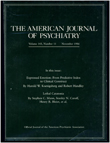Definitions of mania: concordance and prediction of outcome
Abstract
The authors compare several definitions of mania in three series of patients. All the definitions were successful in selecting patients with a favorable outcome, but there were large differences in the number of patients diagnosed, ranging from 17 to 55. The Research Diagnostic Criteria (RDC) distinction between mania and schizoaffective mania proved useful in that the schizoaffective patients continued to show schizophrenic and paranoid symptoms, had more manic episodes, and had a poorer social outcome. The DSM-III tripartite division into nonpsychotic mania and two subgroups of psychotic mania did not appear to have a clear advantage over the RDC dichotomy in the prediction of outcome.
Access content
To read the fulltext, please use one of the options below to sign in or purchase access.- Personal login
- Institutional Login
- Sign in via OpenAthens
- Register for access
-
Please login/register if you wish to pair your device and check access availability.
Not a subscriber?
PsychiatryOnline subscription options offer access to the DSM-5 library, books, journals, CME, and patient resources. This all-in-one virtual library provides psychiatrists and mental health professionals with key resources for diagnosis, treatment, research, and professional development.
Need more help? PsychiatryOnline Customer Service may be reached by emailing [email protected] or by calling 800-368-5777 (in the U.S.) or 703-907-7322 (outside the U.S.).



